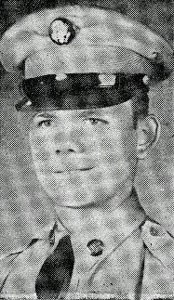George Jacob Shank, age 24, from Fostoria, Ohio, Seneca county.
Parents: Ema Jane Shank
Service era: Korea
Date of death: Wednesday, November 1, 1950
Death details: During the last week of October 1950, Republic of Korea (ROK) Army forces under the control of the U.S. Eighth Army were advancing deep in North Korean territory, approaching the Yalu River on the Chinese-Korean border. Chinese Communist Forces (CCF) struck back in a surprise attack, engaging the ROK 1st and 6th Divisions near Unsan, some sixty miles north of Pyongyang. The U.S. 1st Cavalry Division, with the 8th Cavalry Regiment in the lead, was rushed forward to reinforce the ROK units in the Unsan area. On November 1, the regiment’s 1st Battalion took up positions north of Unsan, while the 2nd Battalion moved to guard the Nammyon River valley west of town, and the 3rd Battalion was placed in reserve at the valley’s southern end. Sergeant First Class George Jacob Shank joined the U.S. Army from Ohio and was a member of Company G of the 2nd Battalion, 8th Cavalry Regiment, 1st Cavalry Division. On November 1, 1950, Company G was in defensive positions with the 2nd Battalion near Unsan, when it came under intense rocket and mortar attacks and infantry assaults and was forced to withdraw. Sergeant First Class Shank went missing during this action, though circumstances surrounding his loss are unknown. He was never officially reported as a prisoner of war, and his remains have not been identified among any returned to the U.S. following the war. Today, Sergeant First Class Shank is memorialized on the Courts of the Missing at the National Memorial Cemetery of the Pacific.
Source: National Archives, Defense POW/MIA Accounting Agency, Sandusky Register (1950)
